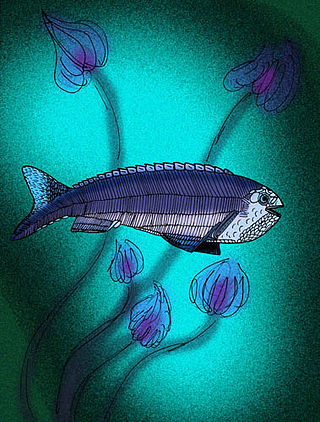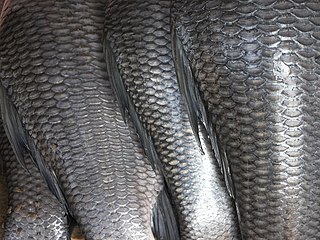
October Revolution Island is the largest island of the Severnaya Zemlya group in the Russian Arctic. It is named after the October Revolution which led to the former Russian Empire becoming a Socialist country.

Pioneer Island is part of the Severnaya Zemlya group in the Russian Arctic. It measures 1,527 km2 (590 sq mi) in area. The island was discovered by Georgy Ushakov and Nikolay Urvantsev during their 1930-32 expedition.

Thelodonti is a class of extinct Palaeozoic jawless fishes with distinctive scales instead of large plates of armor.

Anaspida is an extinct group of jawless fish that existed from the early Silurian period to the late Devonian period. They were classically regarded as the ancestors of lampreys, but it is denied in recent phylogenetic analysis, although some analysis show these group would be at least related. Anaspids were small marine fish that lacked a heavy bony shield and paired fins, but were distinctively hypocercal.

Thelodus is an extinct genus of thelodont agnathan that lived during the Silurian period. Fossils have been found in Europe, Asia and North America.

Birkenia is a genus of extinct anaspid fish from Middle Silurian strata of Northern Europe, and Middle Silurian to possibly Earliest Devonian strata of Arctic Canada. Birkeniid anaspids are covered by a series of small plates on the head and rod-shaped scales in a cheveron-like pattern on the trunk.

Phlebolepis is an extinct thelodont agnathan genus belonging to the family Phlebolepididae. Whole fossils are found in Late Silurian aged strata from Saaremaa, Estonia. Phlebolepis elegans was average-sized for a thelodont, 7 cm long.

A fish scale is a small rigid plate that grows out of the skin of a fish. The skin of most jawed fishes is covered with these protective scales, which can also provide effective camouflage through the use of reflection and colouration, as well as possible hydrodynamic advantages. The term scale derives from the Old French escale, meaning a shell pod or husk.
Longodus is an extinct genus of thelodont, placed in its own family – Longodidae – which existed in what is now Estonia during the Ludlow epoch of the upper Silurian period. The type and only species is Longodus acicularis. They are most noted for their long, needle-like scales, which run vertically along their trunk.

Loganellia is a genus of jawless fish which lived between 430 and 370 million years ago, during the Silurian and Devonian periods of the Paleozoic. Loganellia belonged to the Thelodonti class and like other Thelodonts possessed scales instead of plate armor.
Canonia is an extinct genus of jawless fish found in Canada. There are two species in this genus, C. grossi and C. costulata. The C.grossi specie is thought to be from the Devonian Period. Fossils of C.grossi have been found in the Boothia Peninsula.

Furcacaudiformes is an extinct order of jawless fish in the class Thelodonti.

Thelodontiformes is an extinct order of jawless fish of the Silurian.

Furcacaudidae, the "'fork-tailed' agnathans," is an extinct family of thelodontid agnathans from the Lochkovian stage of the Early Devonian epoch and Wenlockian epoch of the Silurian, known from fossils found in Northern Canada. It is the type family of the order Furcacaudiformes, and itself currently includes 6 known species. It was officially described in 1998 by Mark V. H. Wilson and Michael W. Caldwell.

Archipelepidiformes is an order of extinct jawless fishes in the class Thelodonti.

Archipelepis is a genus of extinct thelodont agnathans, and are the most primitive recognized thelodonts of which whole body fossils are known. Fossils of bodies and scales are currently known from Late Telychian to Wenlock-aged marine strata of northern Canada.

Phlebolepididae is an extinct thelodont agnathan family in the order Phlebolepidiformes.
Erepsilepis is an extinct thelodont agnathan genus in the family Phlebolepididae.
Tiiu Märss is an Estonian geologist and palaeoichthyologist.
Oeselia mosaica is a fossil jawless fish and is the only species in its genus and in the family Oeseliidae. It is a member of an extinct family of thelodonts or jawless fishes. The family and genus were established along with the description of the species by Tiuu Märss in 2005.












